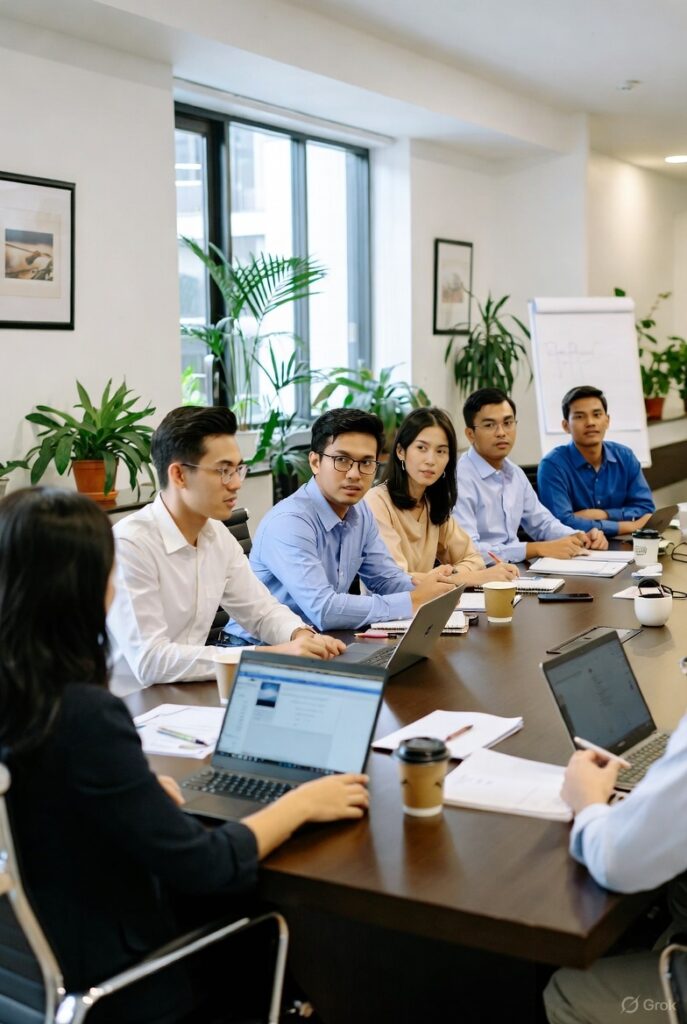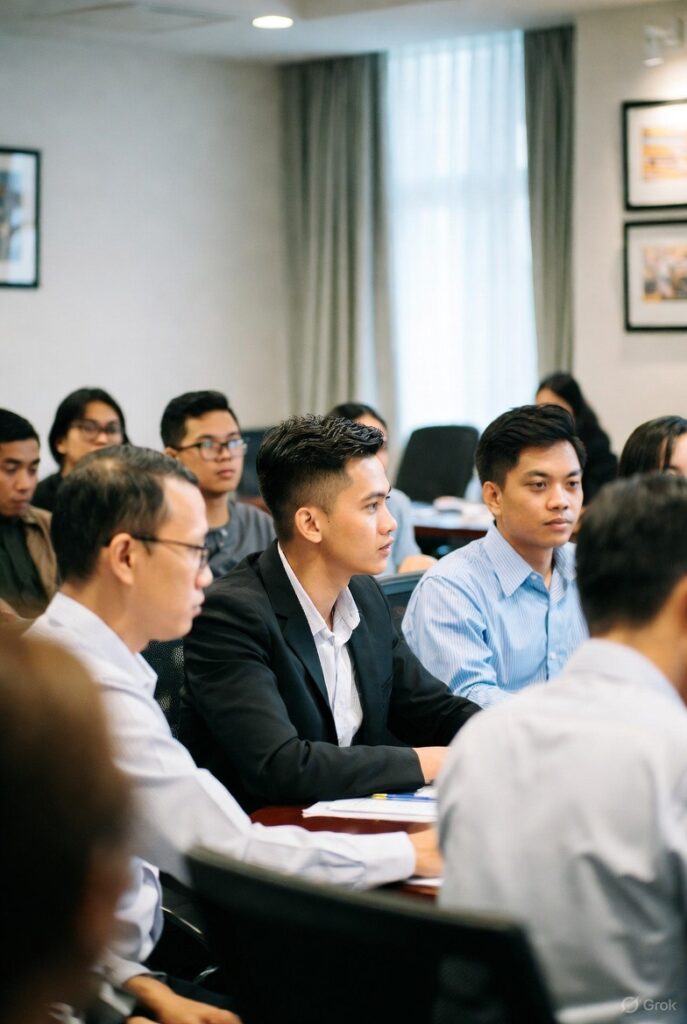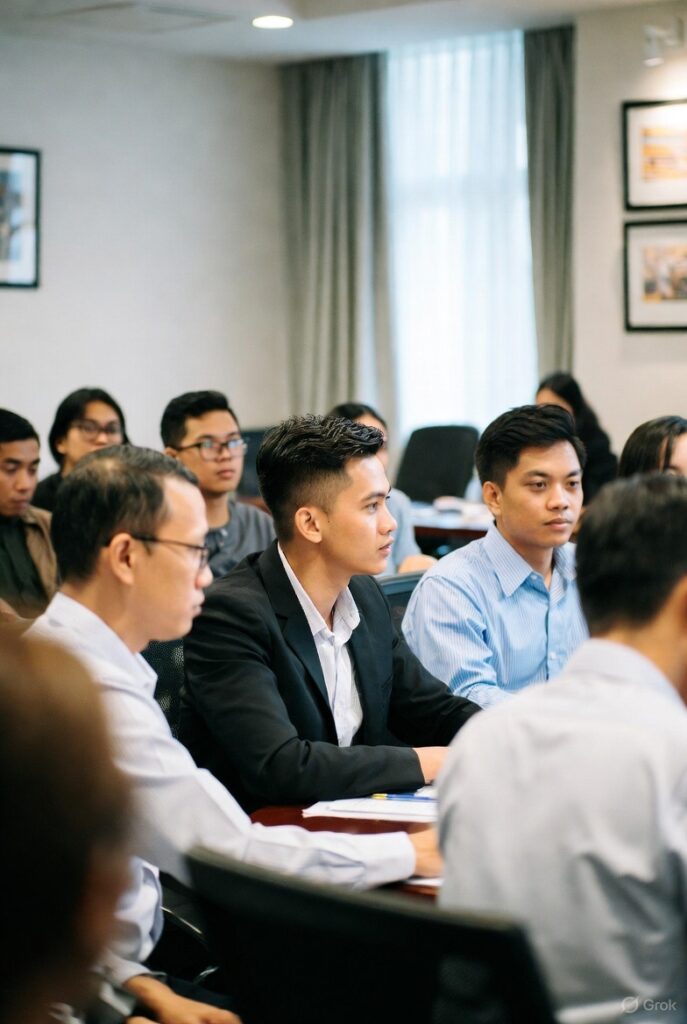- requires careful planning and attention to several key aspects

1. Define the Purpose and Objectives
- Clear Objectives: Decide what the main goals of the meeting are. For example, to make guest service better, to talk about work problems, or to share new hotel rules.
- Agenda: Make a simple list that shows all the topics to talk about and how much time each one will take.
_______________________
Before a meeting, it is very important to know its purpose and objectives. This helps everyone understand why the meeting is happening. First, set clear objectives. Decide what the main goals are. For example, the meeting can be to improve guest service, solve problems at work, or explain new hotel rules. Clear goals help the staff focus and make the meeting useful.
Next, make a simple agenda. An agenda is a list of all the topics to talk about. It shows what will be discussed and how much time each topic will take. This helps keep the meeting organized and on time. Share the agenda with the staff before the meeting. When people know the topics in advance, they can prepare ideas or questions.
By defining the purpose and making a clear agenda, the meeting will be focused, useful, and easier for everyone to understand.
________________________
to require – to need something
careful – paying attention, not making mistakes
attention – looking or listening carefully
key aspects – important parts of something
a purpose – the reason for doing something
a clear objective – a simple, clear goal
to decide – to make a choice
main goals – the most important aims
to improve – to make better
to solve a problem – to find an answer to a difficulty
to explain rules – to say how to do something
to focus – to pay attention to one thing
a simple agenda – a short plan of things to do
to be on time – to arrive when expected
to share something – to give or tell something to others
in advance – before something happens
to define a purpose – to say clearly why you do something
#################
2. Select the Right Participants
- Relevant Attendees: Invite people who are part of or affected by the meeting topics, such as managers, supervisors, and front-line staff.
- Balanced Representation: Invite people from different departments and levels so there are many ideas and opinions.
_______________________
Choosing the right people for a meeting is very important. First, invite staff who are part of or affected by the meeting topics. This can include managers, supervisors, and front-line employees. These are the people who can give useful information and help make decisions.
Second, make sure to have a balanced group. Invite people from different departments, such as reception, housekeeping, and food & beverage. Include staff from different levels, like senior staff and junior staff. This way, you get many ideas and different points of view.
A balanced group helps the meeting be more effective because people share experiences from their own areas. It also makes staff feel included and respected. Avoid inviting too many people who are not related to the topic because this can make the meeting long and less useful.
Choosing the right participants makes meetings better and more productive.
______________________
to choose – to pick one thing from many
to invite – to ask someone to come
to be affected by a topic – to feel or care about a subject
to include – to have someone or something as part of a group
an employee – a person who works for a company
useful information – facts or details that help you
to make decisions – to choose what to do
a balanced group – a group with different people and ideas
a point of view – someone’s opinion
to be effective – to work well and get results
to share an experience – to tell others what happened to you
to feel included – to feel part of a group
to feel respected – to feel people treat you well
to avoid – to stay away from something
to be related to a topic – to connect to a subject
################
3. Choose an Appropriate Time and Venue
- Convenient Timing: Choose a time that does not disturb hotel work and is easy for most people to attend.
- Comfortable Venue: Find a quiet and comfortable place in the hotel where everyone can sit and listen well.
_____________________
When planning a staff meeting, it is very important to choose a good time and a good place. The meeting should not disturb hotel work or guest service. Try to pick a time when most staff can join easily. For example, avoid very busy hours or shifts when many people are working with guests.
The venue must be comfortable and quiet. Choose a room where everyone can sit and see each other. There should be enough space for all participants. The room should also be free from noise so people can listen and speak easily.
It is helpful to check the room before the meeting. Make sure chairs, tables, and any equipment like a projector or whiteboard are ready. A good time and a good place help staff focus, speak freely, and make the meeting useful for everyone.
_______________________
to disturb – to bother or interrupt someone
to pick a time – to choose when something happens
to join easily – to take part without problems
to avoid busy hours – to stay away from times when many people are active
a venue (meeting) – the place where a meeting happens
a participant – a person who takes part in something
free from noise – quiet, no loud sounds
to make sure – to check that something is correct or ready
equipment – tools or things you need for an activity
to focus – to pay full attention
to speak freely – to say what you think without fear
to make a meeting useful – to do things in a meeting that help reach goals
################
4. Prepare and Distribute Materials
- Pre-Meeting Materials: Send the agenda and any information before the meeting so people can prepare.
- Visual Aids: Make slides, charts, or pictures that help people understand the discussion better.
________________________
Before a meeting, it is important to prepare and share materials so everyone is ready. First, make a clear agenda. The agenda shows the topics to talk about and the time for each topic. Send the agenda and any important information to all participants before the meeting. This helps staff know what to expect and think about ideas in advance.
Next, prepare visual aids. Visual aids can be slides, charts, or pictures. They help people understand the discussion more easily. Use simple words, clear charts, and easy-to-read slides. Make sure all materials are organized and ready before the meeting starts.
Sharing materials early and using visual aids makes the meeting better, faster, and easier to follow. Staff can prepare, follow the discussion, and give good ideas. It helps the meeting reach its goals successfully.
_________________________
to share something – to give or tell something to others
a clear agenda – a simple plan of things to do
a topic – the subject you talk about
to expect – to think something will happen
in advance – before something happens
a visual aid – a picture, chart, or object that helps explain something
slides – pictures or text on a computer screen for a presentation
charts – drawings that show information or numbers
to share materials – to give documents or tools to others
to reach a goal – to finish or complete something you want
to be successful – to do something well and get good results
##################

5. Facilitate Effective Communication
- Opening Remarks: Start the meeting with a short welcome and explain what the meeting is about.
- Active Participation: Let everyone share their ideas and opinions.
- Focused Discussion: Talk only about the topics on the agenda and manage the time well.
______________________
Good communication is very important in a meeting. First, start the meeting with opening remarks. Give a short welcome to everyone and explain clearly what the meeting is about. This helps all participants understand the purpose and feel ready to join.
Next, encourage active participation. Ask everyone to share their ideas and opinions. Everyone’s voice is important, and good ideas can come from any staff member. Listen carefully to what others say and respect their opinions. This makes the meeting friendly and open.
Finally, keep a focused discussion. Talk only about the topics on the agenda. Do not go off-topic. Manage the time well so every item gets attention. Make sure no one talks too long and everyone has a chance to speak.
By opening well, letting everyone participate, and staying focused, a meeting becomes clear, effective, and useful for all staff.
______________________
communication – talking or sharing information with others
opening remarks – the first words at the start of a meeting or talk
a purpose – the reason for doing something
to feel ready to join – to feel prepared to take part
to encourage participation – to help people join and take part
to share an opinion – to say what you think
to respect opinions – to listen and be polite about what others think
a focused discussion – a talk where people stay on the topic
off-topic – not about the main subject
to manage the time well – to use time in a good way
an item gets attention – people focus on one thing
to be effective – to work well and get good results
################
6. Address Key Topics
- Operational Efficiency: Talk about how to make daily work faster and easier.
- Guest Experience: Discuss how to make guests happier and fix any repeating guest problems.
- Training and Development: Find out what kind of training staff need to do their jobs better.
- Policy Updates: Explain any new rules or changes to old ones clearly.
- Feedback Mechanism: Give time for staff to share what they think about work and how to make it better.
_______________________
In a staff meeting, it is important to talk about the main topics to help the hotel and staff work better.
Operational Efficiency: Discuss how to make daily work faster and easier. Look for ways to save time and reduce mistakes.
Guest Experience: Talk about how to make guests happier. Solve any problems that happen often. Share ideas to give better service.
Training and Development: Find out what training staff need. Help staff learn new skills so they can do their jobs well.
Policy Updates: Explain any new rules or changes to old rules clearly. Make sure everyone understands and follows them.
Feedback Mechanism: Give time for staff to share their thoughts and ideas. Listen to their suggestions to improve work and guest service.
By discussing these points, the meeting helps the team work better and improve guest satisfaction.
_______________________
the main topics – the most important subjects
operational efficiency – doing work in a good and fast way
to save time – to use less time
to reduce mistakes – to make fewer errors
guest experience – how guests feel and enjoy their stay
to solve problems – to find an answer to a difficulty
to share ideas – to tell others your thoughts
training and development – learning new things to get better at work
new skills – new abilities or things you can do
policy updates – new rules or changes in rules
to explain – to tell someone how something works
clearly – in a way that is easy to understand
to follow rules – to do what the rules say
feedback mechanism – a way to give or get opinions about work
to share thoughts – to say what you think
to listen to suggestions – to hear and think about advice or ideas
to improve work – to make work better
guest satisfaction – how happy guests are
#################
7. Action Items and Follow-Up
- Assign Responsibilities: Say clearly who will do each task and when it must be finished.
- Meeting Minutes: Write down what was discussed in the meeting and send it to everyone soon after.
- Follow-Up: Plan another meeting to check progress and talk about any new problems.
_________________________
After a meeting, it is very important to know what to do next. Assign Responsibilities clearly. This means saying exactly who will do each task and when it should be finished. Every staff member should know their job and deadline.
Meeting Minutes are also important. Write down what was discussed in the meeting. Include decisions, tasks, and important points. After the meeting, send the notes to everyone so all staff know what happened. This helps people remember their responsibilities and stay informed.
Follow-Up is the next step. Plan another meeting to check progress on the tasks. Talk about what is finished and what is still needed. Also, discuss new problems or challenges. Follow-up meetings help staff stay organized, improve work, and make sure that tasks are completed on time.
Good action items and follow-up make meetings effective and useful for everyone.
_________________________
to assign responsibilities – to give jobs to people
a deadline – the day or time something must be finished
meeting minutes – notes about what happened in a meeting
a decision – a choice made after thinking
a task – a job or piece of work to do
to stay informed – to know what is happening
a follow-up – an action after a meeting or event to check progress
to check progress – to see how work is going
a challenge – a difficult job or problem
to improve work – to make work better
to complete on time – to finish by the deadline
an action item – a specific task to do after a meeting
an effective meeting – a meeting that works well and achieves its goals
##################

8. Evaluate the Meeting
- Feedback Collection: Ask people what they think about the meeting and how to make it better next time.
- Continuous Improvement: Use this feedback to make future meetings more useful and better organized.
_________________________
After a meeting, it is important to see how well it worked. First, ask all participants for feedback. Ask them what they liked, what was clear, and what was not clear. Also, ask for ideas on how to make the meeting better next time. Listening to staff opinions helps everyone improve together.
Use this feedback for continuous improvement. Make changes to the agenda, topics, or how the meeting is organized. This makes future meetings more useful, faster, and more interesting for everyone.
Finally, plan a follow-up meeting. In this meeting, check the progress of the tasks or action items from the first meeting. Talk about any new problems or challenges. Make sure everyone knows their responsibilities and deadlines.
Evaluating and following up helps the team work better, communicate clearly, and make guests happy.
_________________________
a feedback – information about how someone did a job or task
an opinion – what someone thinks or believes
to improve together – to get better as a group
continuous improvement – always making work better
a follow-up meeting – a meeting after the first one to check progress
to check the progress – to see how work is going
an action item – a task to do after a meeting
to evaluate – to look at something and decide how good it is
##################
9. Encourage a Positive Atmosphere
- Positive Tone: Be friendly and respectful during the meeting.
- Recognition: Say thank you to staff for their good work and effort.
- Engagement: Make the meeting interesting and active so everyone feels part of it.
_________________________
In a staff meeting, it is very important to have a positive atmosphere. This means everyone feels happy, respected, and included.
First, keep a friendly and respectful tone. Speak politely and listen carefully to everyone. Avoid negative words or blaming people. Smile and show that you value your team.
Second, give recognition. Thank staff for their good work and effort. Notice when someone does something well. Saying “well done” or “thank you” makes people feel proud and motivated. Recognition helps staff work better and enjoy their jobs.
Third, encourage engagement. Make the meeting active and interesting. Ask questions and let everyone share ideas. Use simple tools like charts, slides, or examples. Give small tasks or discussions so everyone can take part.
A positive atmosphere helps staff feel valued, improves teamwork, and makes meetings more effective. Happy staff also give better service to guests.
____________________
a positive atmosphere – a happy and friendly environment
to feel respected – to feel people treat you well
to feel included – to feel part of a group
a respectful tone – speaking politely to others
to avoid negative words – not using rude or bad words
to blame people – to say someone is at fault
to value a team – to think a team is important
to give recognition – to say someone did a good job
an effort – trying hard to do something
to feel motivated – to feel ready and willing to work
to encourage engagement – to help people join and take part
to share ideas – to tell others your thoughts
tools (charts, slides) – things that help show information
to take part – to join in an activity
to improve teamwork – to make working together better
an effective meeting – a meeting that works well and achieves goals
###############
By following these steps, your meeting with hotel staff will be clear, organized, and help improve both daily work and guest service.
####################
Useful vocabulary:
####################